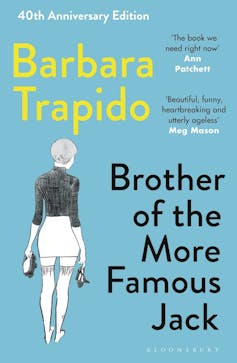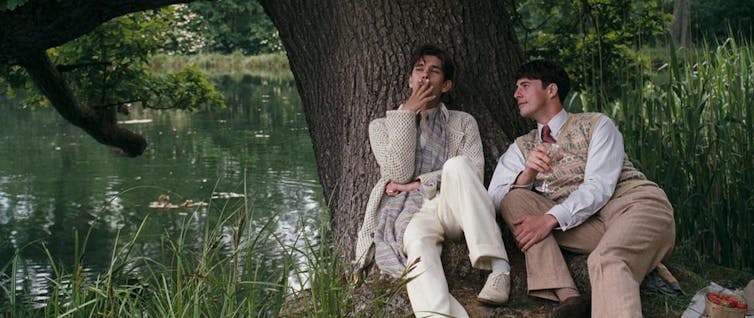
Barbara Trapido’s debut novel, Brother of the More Famous Jack, is one of those books that seems destined to reach its readers in roundabout ways.
Like American novelist and Trapido fangirl Maria Semple, who has written the introduction to Bloomsbury’s new 40th anniversary edition, you could be lucky and stumble across it in a library sale bin, or a friend will press it into your hands.
Review: Brother of the More Famous Jack by Barbara Trapido (Bloomsbury)
And if by chance you’re asked to review it, you could start by scratching your head because you’ve never heard of this book with its distinctive title – even though it’s been around more than half your lifetime.

Few books survive four decades of near-obscurity and still dazzle, but Trapido’s book does just that. It shimmers among this year’s company of books like some brightly coloured, sharp-witted, mini-skirted dolly bird from the 1960s who has gate-crashed a stuffy dinner party.
Irreverent and sweary, undeniably sexy, this coming-of-age novel plunges ahead unselfconsciously and with unusual candour. Its young protagonist, Katherine Browne, admits to compensating for her natural timidity “with odd flashes of bravado”.
A dozen pages in, and it feels as if an unknown hand has casually flicked on every light in the house, inadvertently blowing all the fuses. Semple describes the book as “Brideshead Revisited meets Sabrina in bohemian 80s London”, and on the back cover, Meg Rosoff also mentions Brideshead, and places it in the 1970s. Neither have nailed its period, though Rosoff comes closest.
To anyone who lived through the years spanned by this book, the first part screams 1960s, from Katherine Browne’s little crocheted hats and thigh-high dresses, to the narrative’s pervasive, overt, and at times slightly perverse sexuality.
Comparisons with Brideshead Revisited occur because 18-year-old Katherine falls for a family, the Goldmans, but there is no whiff of the doomed melancholy that hangs over the tortured cast of Evelyn Waugh’s book. On the contrary, Trapido’s novel is funny and endearing; it is sometimes sad, but most of all it is unashamedly sexy, even lewd.

If it is to be compared with any other book, it might be Nancy Mitford’s The Pursuit of Love, with its large, eccentric family, the Radletts of Alconleigh, and its sharp young women. But while Mitford’s delightfully dotty Radletts belong to the British upper classes, Trapido’s Goldman family are firmly middle-class, left-wing intellectuals.
Risque, razor-sharp and politically incorrect
One of the many reasons we read fiction is to satisfy what Jeanette Winterson calls, in her essay “Writer, Reader, Words”, our “mirror of life” longings. And yet, novelists have never written so cautiously, never self-censored so assiduously, in an effort not to cause offence.
They routinely employ sensitivity readers to tease out knots of privilege, highlight clumsy cultural gaffes, race, gender, and age-demeaning stereotypes and clichés. The result is more inclusive fictional worlds than the real world most of us are living in – the world as it ought to be, rather than as it actually is.
Weeding out undesirable social “isms” is necessary work, and yet it could be argued that such adjustments create a false “mirror of life” reflection, at the same time giving free speech a very considerable knock.
What blows some of those fuses when reading Trapido’s novel – aside from the razor-sharp dialogue – is its absence of political correctness.
Sensitivity readers were not a thing when Brother of the More Famous Jack was written. Anyone who was an adult (or almost adult) during the 1960s will immediately recognise its risqué air of permissiveness, its tendency to talk back to authority. They will recognise, too, a string of sensitivity misdemeanours that may prove slightly shocking to any 21st-century shaped sensibility.
Most of the shocks, though not all, are administered by Jacob Goldman, the larger-than-life Jewish philosophy professor, hairy, boisterous, and opinionated father to the Goldman’s six-strong tribe of children. Jake unapologetically asserts his masculinity, his role as head of the Goldman family, and his near constant state of lust for his wife, Jane, this latter even in front of small children and weekend guests.
“What have you been hatching,” Jacob says, noticing the glow on her cheeks. He puts his hands over her breasts. He has no restraints about laying hands on her in public.
Jacob Goldman’s habit of groping his wife appears not to discomfit Jane, and she is, as he asserts, his lawful wife. Most reviewers love Jacob unreservedly, and perhaps if I had read this book 40 years ago I would have too. Back then, his shameless chauvinism would have seemed like muscle-flexing in the face of second-wave feminism.

All this time later, the domineering male feels rather less lovable – not that Jane doesn’t stand up to him, or his children, for that matter. But Jake’s groping of his wife, his carping about her playing the piano, are less readily digested in the era of the #MeToo movement, so that some of these scenes are a little squirm-making.
In Jacob’s defence, he does not grope other women, and is otherwise kind and protective towards Katherine, who in the early part of the book is one of his first-year philosophy students. And late in the book, when Katherine most needs it, his innate goodness will surface.
Read more: Sex is neither good nor bad, but writing makes it so
Open sexuality and plaited onions
As the only child of a greengrocer and a stay-at-home mother, raised in a quiet suburban brick bungalow notable for its cleanliness, and for its china ducks on the wall, Katherine is enchanted by the Goldmans. Arriving at their rambling and none-too-clean house in Sussex for the first time:
The house, as it presents itself from the road, is like a house one might see on a jigsaw puzzle box, seasonally infested with tall hollyhocks. The kind one put together on a tea tray while recovering from the measles.
Katherine has been whisked away for the weekend by stylish architect John Millet. John is an older gay man who is devoted to Jane Goldman, yet not, it transpires, deterred by either of these facts from having designs on Katherine’s virginity. He is only diverted from sleeping with her in the Goldmans’ guest room at Jacob’s dogged insistence on separate rooms.
“I will not have this old faggot come here to my house in order to indulge a sideline in female children. Not with my pupils. Not with Katherine here. Is that clear to everyone present?”
Katherine perceives a world of difference between Jacob’s calling Millet “an old faggot” and her mother calling him “queer”. She had cried into her pillow over the latter, whereas Jacob’s pronouncement is made with none of her mother’s prim moral censure.
To Jacob, John says challengingly:
“Hey, Jake, your wife is pregnant. What’s the matter with you people?” “We like fucking,” Jacob says.
The word drops like a rock on Katherine’s uninitiated sensibilities, but does nothing to shake Jane’s composure, or John’s.

Like so many useful confrontations, Katherine’s exposure to the openly declared sexuality between Jacob and Jane causes her to reconsider past; in particular, her own parents.
Jacob’s habit of blatantly inviting Jane to accompany him upstairs in the middle of the afternoon helps Katherine to think more charitably of her parents’ demure twin beds “with their matching candlewick spreads”. It helps her to conclude that “passion might go on even under candlewick. Even with the Eno’s Fruit Salts on the table between the beds.”
The Goldman family are ready-made for Katherine – who loves to knit – to fall into, and she quickly knits her way into their hearts. Jane, a “neglected Burne-Jones […] in wellingtons”, invites her into the garden to help plait onions, and soon becomes Katherine’s role model. When she first met Jacob, Jane explains, she was an
upper-class Christian, buttoned up in cashmere. The product of a Scottish nanny and a girls’ boarding school.
She had soon discovered that Jacob was much more fun.
Jane encourages her family to “make chamber music of the ‘Yellow Submarine’ on the flute, violin, piano and descant recorder”, and it is by her persistent efforts that the Goldmans’ eldest son Roger becomes a gifted violinist, and the next eldest, Jonty, pushes on with his flute playing. They sing together, too, and so breathtakingly that Katherine exclaims: “The songs cause me ever after to speak the name of John Dowland with reverence.”
Later, when Katherine knows the Goldmans better, she will scrub the kitchen floor for Jane as an act of pure devotion.
Towards the end, in a long moment, Jane makes a feisty feminist statement in front of her assembled family, telling Katherine what she must demand for herself in motherhood and marriage. That Katherine really doesn’t want to hear what Jane has to say is, sadly, all too believable.
Read more: Friday essay: The Female Eunuch at 50, Germaine Greer's fearless, feminist masterpiece
Plunging into 1960s London
When it was published, Brother of the More Famous Jack was the recipient of a Whitbread Special Prize for Fiction. Its author, born in South Africa, had migrated to England in 1963, when she was in her twenties. There she settled into life as the wife of an Oxford professor and raised children. Somewhere in the 1970s, she began to dream up the characters for this book.
Barbara Trapido’s experience of being plunged into 1960s London perhaps goes some way towards explaining the brilliance of this debut. The writing crackles and fizzes with all the clarity of vision and keen ear for dialogue of the observant outsider, deftly delivering what Maria Semple describes as “a daisy bomb of joy”.
Trapido went on to write six more novels. Some of them share characters, and one – The Travelling Hornplayer – revisits, among other characters, Katherine Browne in another, later phase of her life. If you have not yet read Barbara Trapido, Brother of the More Famous Jack is the place to start.
Carol Lefevre does not work for, consult, own shares in or receive funding from any company or organisation that would benefit from this article, and has disclosed no relevant affiliations beyond their academic appointment.
This article was originally published on The Conversation. Read the original article.







